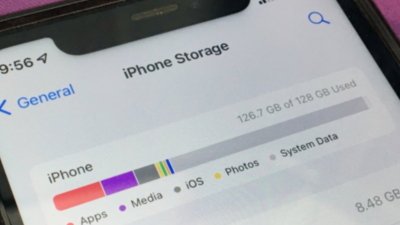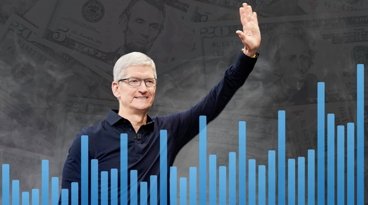Until recently, I’ve been silent on the issue of Apple’s (AAPL) valuation because I feel that such an analysis could be misleading when improperly used to try and forecast Apple’s short or intermediate term price action. Far too many people are betting that Apple will see $300 or $400 a share by this January owing to its strong fundamentals. While I agree that Apple is worth a lot more than what is reflected in its current market price, a long-term viewpoint is the only practical way to rely on fundamental analysis as a basis for investment decisions. Allow me to illustrate.
On August 20, 2008, renowned Apple analyst Gene Munster argued on CNBC’s Fast Money that technology stocks generally tend to outperform in the fall and winter months, and that Apple’s cheap valuation meant that it was time to buy the stock. Munster had a famous $250 price target on Apple at the time. In fact, nearly every analyst on the street had $200 price targets on Apple citing exceptionally strong “fundamentals†as a basis for their recommendations.
Yet, 30 trading sessions later, Apple (AAPL) dropped from $175.84, when Munster and several hundred other market participants were touting the stock as being “undervalued,†to a close of $89.16 on October 7. Apple wouldn’t see $200 a share for almost 15 months. Nearly every analyst on the street flipped 180 degrees on Apple cutting price targets, estimates and citing valuation concerns as a basis for downgrading their buy recommendations to neutral and sell.
RBC analyst Mike Abramsky cut his price target from $200 that August to $125 in late September. Morgan Stanley’s Kathryn Huberty cut her price target on Apple two weeks in a row from $190 to $179 on September 22, 2008 and again from $179 to $115 a share just one week later. By mid-November, Apple stabilized in the $80 to $90 a share range. Even long time Apple enthusiast Jim Cramer noted on several occasions during this period that he couldn’t recommend Apple at $90 a share.
Meanwhile, Apple reported one record quarter after another, and it even posted 125% earnings growth in the September quarter of the financial crisis. The iPhone deferred revenue system masked Apple’s true earnings power making it very difficult for fund managers to adequately valuate the company during the post-crisis P/E compression era. And though the company was undervalued, it didn’t stop the market from pricing the stock at a 70% discount to its theoretical value.
By the end of October, I published a detailed analysis demonstrating that Apple was likely the most undervalued large cap tech stock in the sector. I argued against long time Apple enthusiasts that despite what the investment community might hear from analysts, Apple was a strong buy at $80 a share. I made several arguments as to why the market would bottom in March and that Apple would see $230 within a 2-year period.
Yet, instead of seeing opportunity in Apple’s (AAPL) cheap valuation, Mike Abramsky downgraded the stock to underperform in January 2009, and lowered his price target to $70 a share. The market bottomed just a month and a half later, and Apple significantly outperformed the market posting nearly 250% gains in the next year and a half – more evidence that fundamental analysis is only valuable when used to make long-term predictions. So what exactly did Mike Abramsky’s clients gain from this analysis? Abramsky, like nearly every other analyst, was literally advising clients to buy in the $180 a share range and sell at $80’s a share. Is it any wonder why analysts continue to be the laughing stock of Wall Street?
The lesson here is not that so many got it wrong ahead of and during the financial crisis, however. Rather, what investors should take from this history lesson is that price targets are often good in theory but fatal in fact. Attempting to put intermediate or short-term price targets on any stock based exclusively on fundamental analysis is really an exercise in futility. And before you dismiss the financial crisis as merely an outlier, think again. Apple’s stock has collapsed by over 30% on at least 4 separate occasions over the past few years. See here.
Secondly, and more importantly, it’s very hazardous to rely on a stock’s fundamentals to put a floor underneath its price. All stocks are risky assets, and have the potential to trade at very distressed levels. To unequivocally deny the possibility that Apple could see a short or intermediate term collapse just because it has strong fundamentals is one of the most dangerous viewpoints that anyone could entertain. While its very unlikely that Apple will see such distressed levels anytime soon, the point here is that strong fundamentals don’t make certain stock immune from torture.
Quite often, investors are forced to unload their biggest winners in order to meet hedge fund redemption requests. Other times funds de-risk by shifting-away from an equity strategy to the safe haven of less riskier assets in fixed income. Macro-economic concerns can lead to massive short-term declines in share value. There are countless factors that can conspire to bring Apple down to extreme levels. In fact, colossal mutual funds outflows have been ongoing for the past several months, indicating that a major sell-off might loom on the horizon. With a major lack of market participants, any major event can completely unhinge this market.
Research in motion (RIMM) is a fundamentally sound institution that is clearly undervalued on any widely accepted metric of valuation. That doesn’t stop the inefficient market from pricing the stock at less than half of what ought to be worth. Every stock, including Apple, is at the whim of the larger concerns of the broader market.
So just because a stock has strong fundamentals, just because it is undervalued based on widely accepted metrics, or just because everyone has $300 to $400 price targets doesn’t mean that the stock will see those levels in any short or intermediate term time frame. Instead, the only advantage available to investors is having a long-term viewpoint of the markets. Apple is probably worth $400 a share – but only in the long term. The only thing one can say with any degree of confidence is that Apple will probably see much higher levels some time within the next few years.
Keeping these reservations in mind, I’ll be offering a thorough fundamental analysis of the company. But I would be remiss if I didn’t first disclose just how cautious investors should be when entertaining these very theoretical exercises. Price targets are really just a picture of what a company ought to be trading at in a theoretically rational, and efficient market sometime in the distant future. And yet, this market is rarely rational and hardly efficient in its pricing structure. Please don’t take my skepticism of using fundamentals to forecast short-term price action as general skepticism toward Apple. That would be a gross misinterpretation of this analysis. Instead, view this analysis as a sigh of caution regarding fundamental analysis in general. Stay tuned.
Andy Zaky is a graduate from the UCLA School of Law, an AppleInsider contributor and the founder and author of Bullish Cross — an online publication that provides in-depth analysis of Apple's financial health.
 Andy M. Zaky, Bullish Cross, Special to AppleInsider
Andy M. Zaky, Bullish Cross, Special to AppleInsider
-m.jpg)






 Malcolm Owen
Malcolm Owen
 Christine McKee
Christine McKee
 Charles Martin
Charles Martin


 William Gallagher
William Gallagher
 Amber Neely
Amber Neely










54 Comments
Buy AAPL !!!
What can I say... You nailed, at least I totally agree and think most of those analysis failed. Apple is growing and growing and is unfair to under valuate it the way it has been. Some analytics are very miss leading. For example the last round of android share and other examples. It drives the company stock down without any reason, Apple sill new on the cell phone business and its revenue is far greater that any other smartphone company. Also in mid term Apple could release new products to compliment its phone offerings like another cheaper version or maybe an unlocked one. I think if I will get an unlocked for maybe 400.00 with most of functionality as the current iPhone many other will think the same. I don't care at all internet offered by the carrier, there is a lot of hot spots everywhere, even in my country.
Again great post
Buy AAPL !!!
thanks or summing that up. Now I won't even bother to read the article. no, really- I won't.
It's certainly worth advising people against reading too much into forecasted stock prices, but I'm afraid this analysis neutralizes that advice to a large extent by the references to "overvalued" and "undervalued" stocks. I think an even better message to investors is that no such concept exists. The markets value stocks every day. The collective wisdom of the market tells us what they are worth -- anything else is just a guess or an abstraction. Also, the markets are never rational. Whether they are going up or going down, markets trade on emotion. Once we understand these concepts, then we are prepared to treat forecasted stock prices with the caution they deserve.
I do not trust analysts. Most of them I believe just throw dots on the wall. If you buy and sell on their recommendation, you will be bankrupt. And the ones on the TV shows are even worse, just a bunch of clowns. When they are telling you to buy, they are selling.
Why do one analysts say buy, and the other say sell? Because they are all self-serving brokerage pimps. Their actions make me sick.